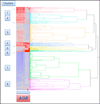RNA surveillance-an emerging role for RNA regulatory networks in aging
- PMID: 20170753
- PMCID: PMC2894286
- DOI: 10.1016/j.arr.2010.02.002
RNA surveillance-an emerging role for RNA regulatory networks in aging
Abstract
In this review, we describe recent advances in the field of RNA regulatory biology and relate these advances to aging science. We introduce a new term, RNA surveillance, an RNA regulatory process that is conserved in metazoans, and describe how RNA surveillance represents molecular cross-talk between two emerging RNA regulatory systems-RNA interference and RNA editing. We discuss how RNA surveillance mechanisms influence mRNA and microRNA expression and activity during lifespan. Additionally, we summarize recent data from our own laboratory linking the RNA editor, ADAR, with exceptional longevity in humans and lifespan in Caenorhabditis elegans. We present data showing that transcriptional knockdown of RNA interference restores lifespan losses in the context of RNA editing defects, further suggesting that interaction between these two systems influences lifespan. Finally, we discuss the implications of RNA surveillance for sarcopenia and muscle maintenance, as frailty is a universal feature of aging. We end with a discussion of RNA surveillance as a robust regulatory system that can change in response to environmental stressors and represents a novel axis in aging science.
Copyright © 2010 Elsevier B.V. All rights reserved.
Figures






Similar articles
-
RNAi screens to identify components of gene networks that modulate aging in Caenorhabditis elegans.Brief Funct Genomics. 2010 Jan;9(1):53-64. doi: 10.1093/bfgp/elp051. Epub 2010 Jan 6. Brief Funct Genomics. 2010. PMID: 20053814 Free PMC article. Review.
-
Ageing: Microarraying mortality.Nature. 2003 Jul 17;424(6946):259-61. doi: 10.1038/424259a. Nature. 2003. PMID: 12867961 No abstract available.
-
Methyl 3,4-dihydroxybenzoate extends the lifespan of Caenorhabditis elegans, partly via W06A7.4 gene.Exp Gerontol. 2014 Dec;60:108-16. doi: 10.1016/j.exger.2014.10.007. Epub 2014 Oct 16. Exp Gerontol. 2014. PMID: 25456844
-
Longevity determined by developmental arrest genes in Caenorhabditis elegans.Aging Cell. 2007 Aug;6(4):525-33. doi: 10.1111/j.1474-9726.2007.00305.x. Epub 2007 May 29. Aging Cell. 2007. PMID: 17521386 Free PMC article.
-
The Role of mRNA Quality Control in the Aging of Caenorhabditis elegans.Mol Cells. 2023 Nov 30;46(11):664-671. doi: 10.14348/molcells.2023.0103. Epub 2023 Nov 13. Mol Cells. 2023. PMID: 37968980 Free PMC article. Review.
Cited by
-
Sex differences in the brain: Implications for behavioral and biomedical research.Neurosci Biobehav Rev. 2018 Feb;85:126-145. doi: 10.1016/j.neubiorev.2017.07.005. Neurosci Biobehav Rev. 2018. PMID: 29287628 Free PMC article. Review.
-
MicroRNAs: miRRORS of health and disease.Transl Res. 2011 Apr;157(4):157-62. doi: 10.1016/j.trsl.2011.02.001. Epub 2011 Feb 11. Transl Res. 2011. PMID: 21420026 Free PMC article.
-
Regulation of senescence by microRNA biogenesis factors.Ageing Res Rev. 2012 Sep;11(4):491-500. doi: 10.1016/j.arr.2012.01.003. Epub 2012 Jan 28. Ageing Res Rev. 2012. PMID: 22306790 Free PMC article. Review.
-
MicroRNAs in Sarcopenia: A Systematic Review.Front Med (Lausanne). 2020 May 28;7:180. doi: 10.3389/fmed.2020.00180. eCollection 2020. Front Med (Lausanne). 2020. PMID: 32549041 Free PMC article.
-
CircularRNA_104670 plays a critical role in intervertebral disc degeneration by functioning as a ceRNA.Exp Mol Med. 2018 Aug 6;50(8):1-12. doi: 10.1038/s12276-018-0125-y. Exp Mol Med. 2018. PMID: 30089772 Free PMC article.
References
-
- Bass BL, Weintraub H. An unwinding activity that covalently modifies its double-stranded RNA substrate. Cell. 1988;55:1089–1098. - PubMed
-
- Berkes CA, Tapscott SJ. MyoD and the transcriptional control of myogenesis. Semin Cell Dev Biol. 2005;16:585–595. - PubMed
-
- Bischoff R. Regeneration of single skeletal muscle fibers in vitro. Anat Rec. 1975;182:215–235. - PubMed
Publication types
MeSH terms
Substances
Grants and funding
LinkOut - more resources
Full Text Sources
Medical

